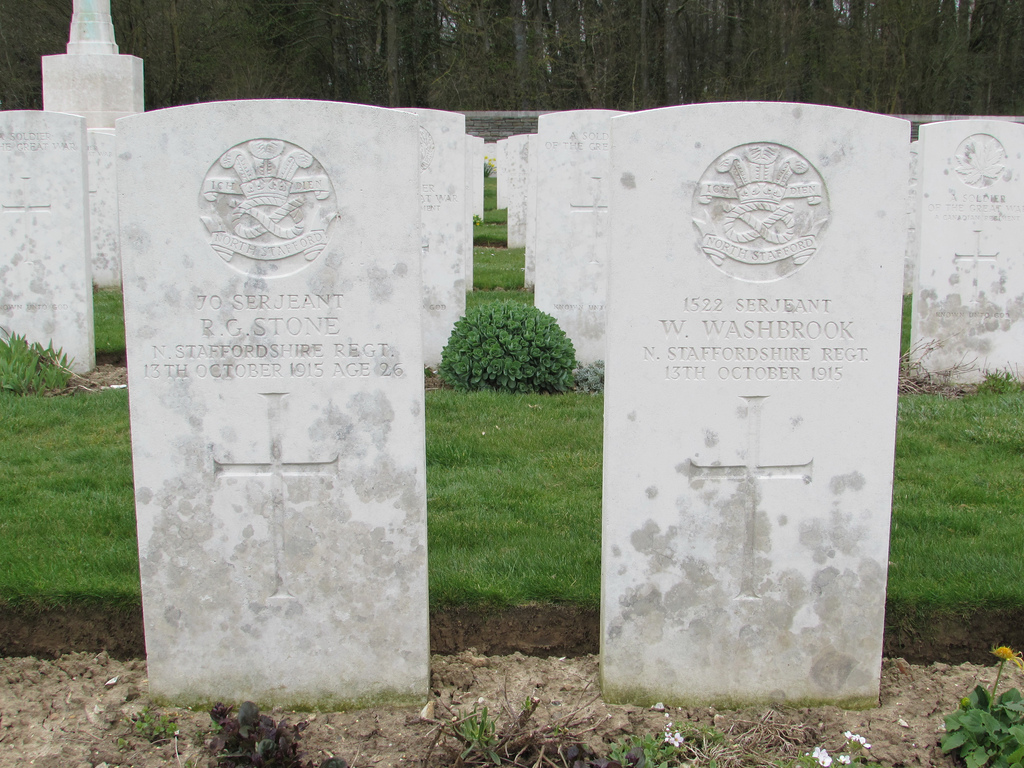
Neuville-Saint-Vaast: Canadian Cemetery No. 2 (Pas-de-Calais)
In the Spring of last yeat, I visited the Canadian National Vimy Memorial for the very first time and spent some time wandering around the memorial park and its associated memorials and cemteteries. One of the CWGC cemeteries in the park is Canadian Cemetery No. 2, one of several cemeteries established by the Canadian Corps near Vimy Ridge in April 1917.
In Plot 14, Row B of Canadian Cemetery No. 2 are two burials that actually have very little to do with Vimy, but are part of a group of burials moved there from the area north of Lens long after the end of the war. The grave markers were for two bellringers from Staffordshire that had been killed in action near the Hohenzollern Redoubt on the 13th October 1915. This was at the tail-end of the Battle of Loos — and long before the British had taken over the Vimy sector from the French Army in early 1916.
The two bellringers were both Sergeants in the North Staffordshire Regiment: Sergeant Walter Richard Washbrook serving with the 1/5th Battalion and Sergeant Reginald Grimmit Stone with the 1/6th. Both battalions were Territorial Force units, with the 1/5th mainly recruiting around Stoke-on-Trent and the 1/6th around Burton-on-Trent. During the Battle of Loos, both battalions had formed part of 137th Infantry Brigade in the 46th (North Midland) Division.
1522 Sergeant Walter Richard Washbrook of the 1/5th North Staffordshire Regiment was a bellringer from Tunstall, near Stoke-on-Trent (Staffordshire). Walter was the son of the prolific peal-ringer James William Washbrook [1]. His three brothers were also bellringers and there are records in the Ringing World of the father and sons ringing together on handbells:
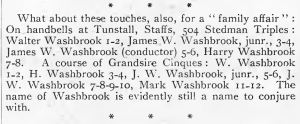
The Ringing World, 15th March 1912, p. 182.
Two of Walter’s brothers, Second Lieutenant Harry Washbrook of the 5th Battalion, The King’s (Liverpool Regiment), and Second Lieutenant Mark Thomas Washbrook of the 5th Battalion, East Lancashire Regiment, would also die during the war. All three of their CWGC grave markers include the inscription: “One of three brothers killed. Faithful in service, even unto death.” Another brother, 10656 Corporal James William Washbrook of the 7th (Service) Battalion, North Staffordshire Regiment, was severely wounded at Gallipoli, but survived the war. The name of Walter Washbrook, as well as those of his brothers, features on the Stoke Archidiaconal Association of Change Ringers memorial in St Peter’s Church, Stoke-on-Trent.
70 Sergeant Reginald Grimmit Stone of the 1/6th North Staffordshire Regiment was a bellringer from St. Paul’s Church, Burton-on-Trent (Staffordshire). At the turn of the twentieth century, the band at St. Paul’s, initially led by William Wakley, was instrumental in popularising the ringing of what remain today as standard bellringing methods. Reginald G. Stone rang in several peals, including the Treble bell to a peal of London Surprise Major in November 1911:
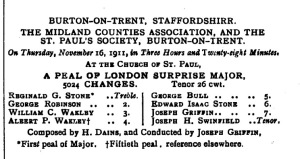
The Bell News and Ringers’ Record, 25th November 1911, p. 440.
The grave concentration records made available by the CWGC indicate that the bodies of Sergeants Washbrook and Stone were found after the war in a grave site located south of Auchy-lez-La-Bassée (now known as Auchy-les-Mines), close to the site of the Hohenzollern Redoubt and Fosse 8 (44a (36c.NW) G.4.d.7.2). They were two of six casualties found in a single grave, which also included 613 Corporal T. Fitzjohn of the 1/5th North Staffords and several others who remain unidentified. Remarkably, while serving in different battalions within the same brigade, these two Staffordshire bellringers ended up being buried in the same battlefield grave. Then, following their discovery and identification, they were moved after the war to rest in adjacent grave plots in Canadian Cemetery No. 2.
At least one other member of the band at St. Paul’s, Burton-on-Trent, Private Albert Percy Wakley of the 1/6th North Staffords, was severely wounded on the 13th October. He survived and later served as a Sergeant in the Labour Corps, but died of influenza on the 18th February 1919, aged 29. He was the son of William Wakley, the tower-master of St Paul’s, and was buried at Burton-on-Trent. Both his and Sergeant Stone’s names feature on the war memorial at St. Paul’s Church.
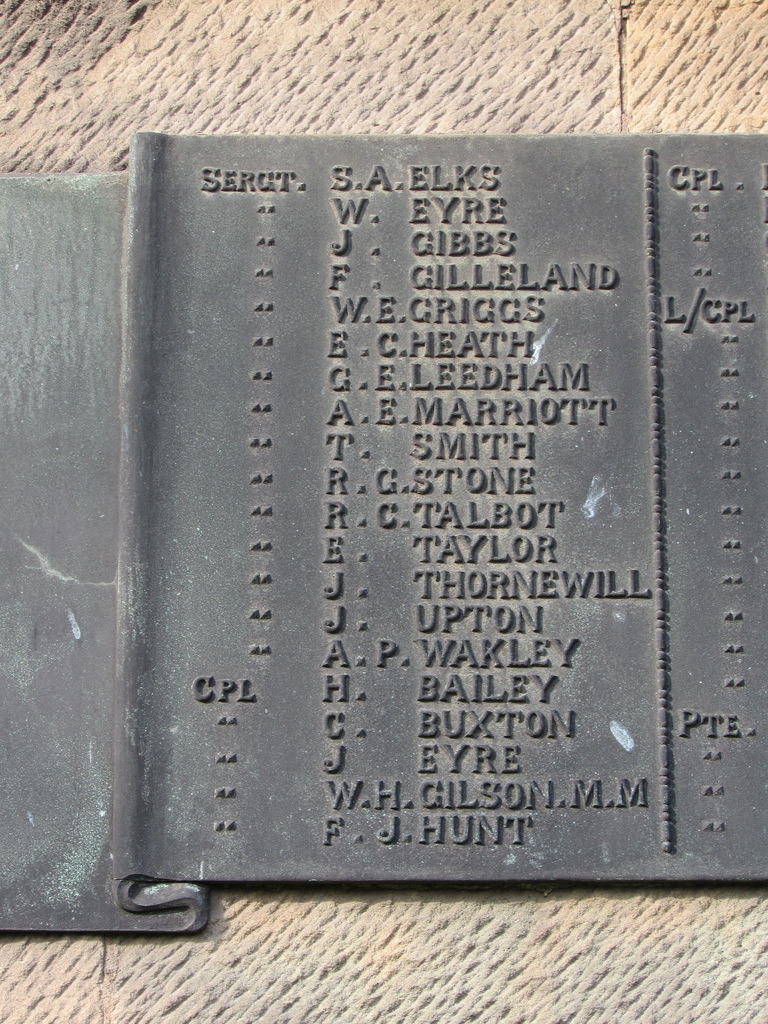
The names of Sergeants R. G. Stone and A. P. Wakley on the St. Paul’s Church War Memorial, Burton-on-Trent (Staffordshire)
The 46th Division at the Hohenzollern Redoubt:
Sergeants Washbrook and Stone were both killed in action on the 13th October 1915 during an attack on the Hohenzollern Redoubt and Fosse 8, north of Lens, by the 46th (North Midland) Division. At that time, both the 1/5th and 1/6th North Staffords formed part of 137th Infantry Brigade, which was sometimes known as the Staffordshire Brigade. The 1/5th were one of the leading battalions in the attack on the redoubt, with the 1/6th following up.

Fosse No. 8. Detail from Trench Map 36C.NW; Scale: 1:20000; Edition: 7A; Published: 1916; Trenches corrected to 12 June 1916: https://maps.nls.uk/view/101465011 Reproduced with the permission of the National Library of Scotland (Creative Commons CC BY-NC-SA 4.0)
The 46th Divison attack on the Hohenzollern Redoubt on the 13th October would be led by the 138th Brigade and the 137th Brigades, with the 140th Brigade in reserve. The 138th would attack the northern and central parts of the Hohenzollern defences, while the 137th would attack the southern part, namely Fosse 8 and a slag heap known as the Dump. In the 137th Brigade sector, the 1/5th North Staffords would lead the attack, with the 1/6th North Staffords following on behind. The attack was planned to happen in the afternoon, and would be supported by an artillery bombardment and by the distribution of smoke and gas. The War Diary of the 1/6th North Staffords provides an outline of what happened from their perspective [2]:
Oct 13th, 12. noon: At 12. noon our Artillery heavily bombarded FOSSE 8 – BIG WILLIE – HOENZOLLERN [i.e. Hohenzollern] REDOUBT, and enemy’s machine gun emplacements, communication trenches.
1. pm. At 1 . pm gas & smoke used against hostile position. Between 1.0 & 1.30 enemy ranged with machine guns onto our trenches, also shelled support trenches.
2. pm. At 2. pm Infantry of 137 Bde advanced against BIG-WILLIE – DUMP TRENCH & FOSSE 8. A & B Coys 6 N. Staffs Regt forming 3rd Line. C &D Coys in fourth line. Enemies machine gun & rifle fire very heavy on advancing infantry who were unable to proceed. Line established in old fire trench. Two bombing parties were found by this Battalion on gaining 30 yards of BIG WILLIE TRENCH but had to retire through heavy casualties & were relieved by 1/5 S. Staffs. Regt.
Enemy kept up a heavy fire on our trenches with their Artillery & machine gun making the work of bringing in wounded a difficult one.
Andrew Rawson’s Battleground Europe book on the Hohenzollern Redoubt notes how quickly the attack was effectively over [3]:
The 1/5th North Staffordshires sustained over five hundred casualties, most had been hit within a few yards of their own trench.
The first two companies of the 1/6th North Staffordshires followed in support:
Under a very heavy rifle and machine-gun fire from the enemy, which accounted for the large number of casualties in the first 200 yards of the advance …. Apparently there were no Company officers left with the leading two companies and the men got grouped together and suffered heavily in consequence, particularly on the left.
Realising that the attack had failed, Lieutenant-Colonel R F Ratcliff ordered his two reserve companies to stand fast.
News of the attack would soon reach Burton-on-Trent. The Burton Daily Mail of the 19th October 1915 quoted extensiveley from Field-Marshal Sir John French’s Despatch [4]:
OUR TERRITORIALS.
THEIR ATTACKS ON THE GERMANS.
UNDER SMOKE AND GAS.
TRENCHES GAINED AND LOST.
LIST OF THE FALLEN.
MANY MEN WOUNDED.
The Burton Territorials, in their fight with the enemy last week, displayed the utmost valour, and according to Major-General F. Stuart-Wortley, the whole Division distinguished itself by its gallantry and showed qualities worthy of the best tradition of the British Army. It is an unfortunate fact that some local men were killed, and many officers and men wounded, but those who fell to rise no more made the supreme sacrifice for King and country, and no nobler duty can fall to the lot of men.
The charge they made took place last Wednesday afternoon, and at the given signal the local Territorials, on conjunction with the other forces, leaped from their trenches and swept across the intervening space to the German trenches, from which they swept the enemy, including the Prussian Guards, and captured the trench, inflicting great punishment on the enemy.
In view of the importance of the attack to Burton, it is worth reproducing the despatch of Field-Marshal Sir John French, which we printed on Friday last. It will be noted that the onslaught was made under a cover of smoke and gas, and that though our men captured 1,000 yards of trenches, they had to give them up again to the Germans in consequence of shell fire. The despatch was as follows: —
General Headquarters.
Thursday, 7.25 p.m.
Yesterday afternoon, after a bombardment, we attacked under cover of a cloud of smoke and gas from a point about 600 yards south-west of Hulluch to the Hohenzollern redoubt.
We gained about 1,000 yards of trench just south and west of Hulluch, but were unable to maintain our positions there owing to the enemy’s shell fire.
South-west of St. Elie we captured and held the enemy’s trenches behind the Vermelles-Hulluch road and the south-western edge of the quarries, inclusive.
We also captured a trench on the north-western face of the forest.
We captured the main trench of the Hohenzollern Redoubt, but the enemy are still in the communication trenches between the redoubt and the quarries.
THE MEN’S DISTINGUISHED GALLANTRY.
‘WORTHY OF THE BEST TRADITIONS OF THE BRITISH ARMY.’
PRAISE FROM MAJOR-GENERAL STUART WORTLEY.
Major Baines, the secretary to the Notts. Territorial Force Association, has just received a letter from Major-General F. Stuart-Wortley, the General Officer Commanding the 46th Dividsion, praising in warm terms the work in action of the units which comprise the North Midland Division. Included in that division it is interesting to point out are the 6th Battalion North Staffordshire Regiment, the Robin Hoods and the 8th Battalion Sherwood Foresters (County Territorials), who were complimented some time ago by General French. The letter, which is dated October 16th, is in the following terms:–
I should be obliged if you would inform the president and members of your association that in a recent attack on the enemy’s position, the North Midland Division behaved with distinguished gallantry, worthy of the best traditions of the British Army.
I trust their example may arouse enthusiasm in their various counties, and that the result of their gallant efforts may be to bring every able-bodied man into the ranks.
I am proud to command a division composed of officers and other ranks who, for love of King and country, have sacrificed private interests, and whose example should be widely followed by every man imbued with patriotic enthusiasm.
I should be glad if every one could be informed of this.
The same newspaper also published information on known casualties as well as extracts from letters written by those at the front. Two of the more detailed ones were:
PRIVATE HARRY GOODHEAD.
A letter received by the parents of Private A. W. G. Brown, 1st 6th North Staffords, Mill Hill Lane, Winshill, this morning, conveyed the sad intimation that two of his comrades had been killed, one being Private Harry Goodhead, son of Mrs. Goodhead, of Church Hill Street. The writer states that before the charge they agreed amongst themselves that if one went under the survivor would write to his people conveying the news. He states that they leapt over the parapet at 2 p.m., and for three or four hours it was like being in Hell. Poor Harry and —–, both died instantaneously, without suffering pain. They died heroes’ deaths, and he was writing to Mrs. Goodhead to tell her about it.
Private Harry Goodhead, who was 20 years of age, was employed at Messrs. Salt and Co.’s Brewery, and enlisted when the war broke out. There were only three eligible men in his family – all serving, and one of his brothers, also in the 6th North Staffords, was invalided home some time ago.
CORPORAL J. H. JONES.
Corporal J. H. Jones, son of Mr and Mrs. Jones, of Mill Hill Lane, Winshill, a member of the 1st 6th North Staffords, has sent a letter home, in which he says to his mother:
“We attacked the Prussian Guards on the 13th. I went over the parapet with the boys. We captured the trenches. I was blown up by a shell and half buried. It stunned me, but I kept still and was lying in the open for half the night, and then I scrambled in an old trench and got in my own battalion. I have not a single wound on me, only the medical officer sent me to the hospital. A lump of shell hit my head and made it ache a bit and another hit my stomach and doubled me up. However, I am in hospital in a big French town and [am] feeling none the worse, excepting that my head aches and my stomach is sore, especially when I walk. I expect that we shall be moved to the base as soon as possible.”
Mr Jones, father of Corporal Jones, is a member of the 2nd 6th Battalion North Staffordshire Regiment Supernumerary Company, now stationed in the north, and he has a brother-in-law, Lance-Corporal A. E. Wooldridge, who is in the 10th King’s Royal Rifles, who is also now in France.
Some more information on the attack, which pays tribute to the virtues of cricket, appeared in the Burton Daily Mail of the 28th October 1915 [5]:
ATTACK AT HOHENZOLLERN.
HOW THE REDOUBT WAS TAKEN.
A vivid account of the fighting at the Hohenzollern Redoubt, when the Burton Territorials suffered so severely, has been given by an officer, who himself came out unscathed, although shot and shell fell all around him.
For three hours, he said, our artillery had been heavily bombarding the Hohenzollern Redoubt, and the German trenches and other positions in the vicinity. It seemed impossible that anyone could live through such a storm of shell, but the enemy’s dug-outs were often 30 feet deep, and were in many cases impervious to our fire. At one o’clock we started the gas and smoke, and soon afterwards two attacking brigades, including the Lincolns, Leicesters, and Staffords, began the attack, the Notts. and Derbys being held in reserve.
THE MACHINE GUN FIRE.
Most of the casualties were caused by machine gun fire. The distance from the British trench facing the redoubt was not more than 150 yards, and our men had covered a third of it before the enemy spotted them – a real bit of luck. The chief cause of trouble was a slag heap, some 50 feet high, to the right rear of the redoubt, called by our men “The Dump,” and a similar eminence to the left rear, christened “Mad Point.” Machine guns galore were posted on these two heights, which command the ground in the vicinity of the redoubt, and although our artillery had paid them particular attention, the result had not been so effective as was supposed, for a perfect hail of lead was poured forth. The enemy’s shell fire was, comparatively speaking, a minor affair.
The work of the Robin Hood bombers was particularly effective. The British, thanks to cricket, can throw these explosives twice as far as the Huns. Our grenades and hand bombs are now excellent. The time when they were improvised from empty jam tins has passed.
The British seem now to have as much in the way of shells as they want.
The disaster as also obvious to others in the battalion. Private Holden of the 1/6th North Staffords was a member of bombing party [6]:
” […] five minutes past two we all mounted the parapet, most of us feeling mad – some wild with thirst for German blood. Then I witnessed the most awful sight I ever saw in all my life. Hundreds fell before we reached the German lines and then didn’t we let into them. I cannot describe what I saw, as I was too excited. Later we got reinforced, as almost all of our officers had either been killed or wounded. I got back into our own trench, thanking God […] “
Even recovering the wounded and dead from the battlefield after dusk was fraught with danger. Sergeant Caleb Norton of the 1/6th North Staffords later recalled [7]:
By this time it was getting dark, and I thought it was a good opportunity to get in some of the wounded we could. First we got in Capt. Jenkinson (Talbot helped). He lay in the open for several hours for it would have been certain death to have gone out to him. After a struggle we got him in. It was a case of being cruel to be kind. As he lay on the fire step, he asked for a doctor. We could not do anything, for there was not an ambulanceman to be found. We made him as comfortable as we could. I could see he had been hit again, for he had an awful wound in his stomach. I watched over him. I could see he could not last long. He lasted about an hour. Then we put him in a small disused trench close by. We covered him over.
The casualty figures provided in the War Diary of the 1/6th North Staffordshires were: seven officers and 53 other ranks killed; ten officers and 211 other ranks wounded, and 30 other ranks missing. Towards the end of the month, Sergeant Norton wrote a letter to his brother providing more insight into the human cost [8]:
Our Battalion lost heavily. I was the only Sergt. that came out without a scratch. In fact all the Officers and N.C.O.’s suffered a lot. There were only three officers, with the Colonel and the Adjutant, came out of it. Sergt. Copeland, Sergt. Hair, Sergt. Cutler, Sergt. Stone were killed and others wounded – yourself, Platts, Austin, Kenney, Hammond, Watts, Shirley, Cpl. Burrows, Clements, Littleford, Cronise – I cannot remember them all. Smalner Smith has died of his wound, also Mason. You will be surprised to see the list of the lot. We had a roll call the next morning. I shall never forget it – the strengths were ‘A’ Company – 90, ‘B’ – 92, ‘C’ – 112, ‘D’ – 114.
Andrew Rawson sums up the scale of the catastrophe [9]:
The Staffordshire Brigade’s first battle had been an unmitigated disaster. Nearly one thousand officers and men had been killed or injured, the majority in the first ten minutes. Instead of capturing the Dump, the Brigade was left struggling to maintain its position in Big Willie Trench. The final words on the attack belong to an anonymous staff officer who eagerly watched the events unfold from the headquarters dugout:
It was wonderful seeing the great smoke cloud along the front, and then five minutes before the bombardment stopped, the figures crawling over the parapet and lying down in front, as far as you could see either side. And at the moment the guns lifted, all got up and began to run or rather jog. Then they all seemed to melt away ….
The combination of inadequate artillery preparation and wanton attacks on well-designed German defences would be perpetuated again on a much wider scale at the Somme on the 1st July 1916 (on that day, the 46th Division itself would be involved in the unsuccessful diversionary attack at Gommecourt). The First Army commander at Loos would by then have become the Commander in Chief.

IWM Q 29001: The Battle of Loos; British attack on the Hohenzollern Redoubt by the 46th (North Midland) Division; photograph shows a cloud of smoke and gas in the centre and on the left. © IWM (Q 29001): https://www.iwm.org.uk/collections/item/object/205194050
There are memorials for the 46th (North Midland) Division at Vermelles, on the road leading to Hulluch, and near the Hohenzollern redoubt.
Acknowledgements:
This post is based on an earlier one on Sergeant Albert Percy Wakley of the 1/6th North Staffords, and a report from a visit to Vimy in March 2019.
References:
[1]. John C. Eisel, Giants of the Exercise II: more notable ringers of the past (Central Council of Church Bell Ringers, 2006), pp. 39-42:
http://www.ringing.info/giants-of-the-exercise-2.pdf
[2] WO 95/2685/2, 1/6th Battalion, North Staffordshire Regiment War Diary, The National Archives, Kew.
[3] Andrew Rawson, Loos – 1915: Hohenzollern Redoubt, Battleground Europe (Barnsley: Leo Cooper, 2003), p. 124.
[4] Burton Daily Mail, 19th October 1915, p. 3; via British Newspaper Archive.
[5] Burton Daily Mail, 28th October 1915, p. 2; via British Newspaper Archive.
[6] Private R. Holden, Sentinel, 30th October 1915, cited in: Andrew Thornton, “We had done all that was expected of us:” Staffordshire’s Territorials and the Assault on the Hohenzollern Redoubt, 13th October 1915, Hellfire Corner, 2000:
http://www.hellfirecorner.co.uk/Thornton/terriers2.htm
[7] Sergeant Caleb Norton, Letter, 30th October 1915, cited ibid.: http://www.hellfirecorner.co.uk/Thornton/terriers2.htm
[8] Sergeant Caleb Norton, Letter, 30th October 1915, cited ibid.:
http://www.hellfirecorner.co.uk/Thornton/terriers4.htm
[9] Rawson, op cit., p. 124.
Update December 15, 2020:
The death of Sergeant Walter Richard Washbrook of the 1/5th Battalion, North Staffordshire Regiment was reported on in the Ringing World in early 1916, including a brief obituary and the suggestion that he may have been recommended for the Distinguished Conduct Medal, an honour that he never received.
Source: Central Council of Church Bell Ringers:
http://cccbr.org.uk/wp-content/uploads/2017/09/rw1916_a.pdf
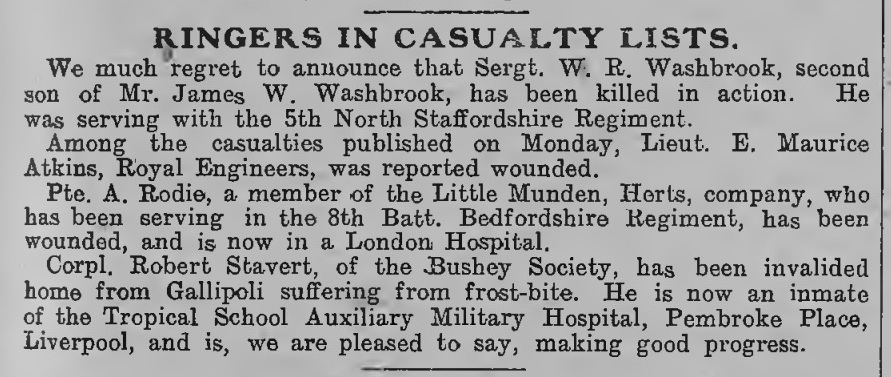
The Ringing World, 28 January 1916, p. 39.
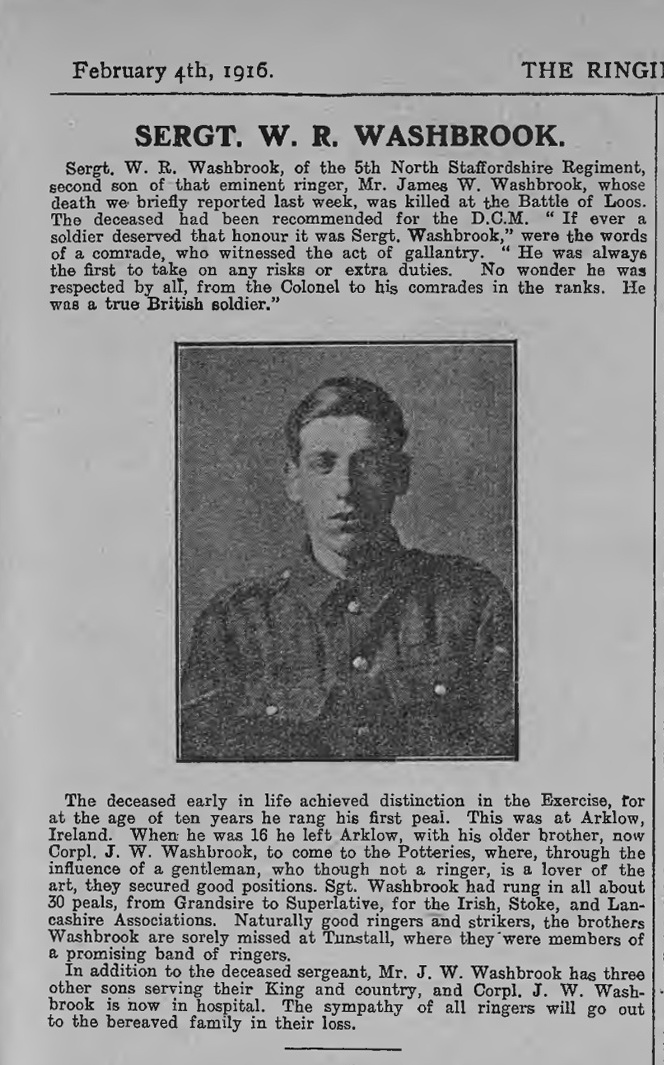
The Ringing World, 4th February 1916, p. 55.
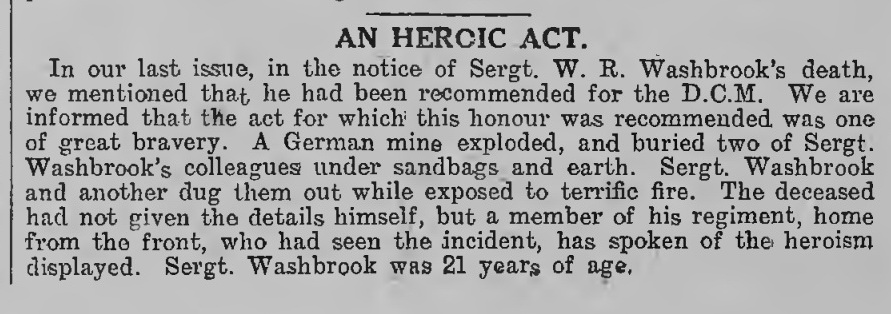
The Ringing World, 11th February 1916, p. 68.

[…] The British would attack again on the 13th October in an attempt to capture German positions at the Hohenzollern Redoubt and Fosse 8, but this was also a costly failure. The Battle of Loos is chiefly now remembered as a German […]
By: Private Richard Hubert Hanks, 10th Battalion, Gloucestershire Regiment | Opusculum on December 4, 2020
at 8:05 am